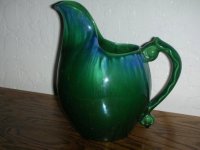goldinmypan
Hero Member
I found this pitcher and when I asked Haeger for any info, they refered me to several books none of which are in my libary. They must be getting an cut from the publishers. I hate to spend a hundred bucks to look up one pitcher. Is there anyone out there with info on Haeger who can help. there is a number on the bottom that appears to be "R583" but it is a little lost in the glaze.
Thanks
Thanks




